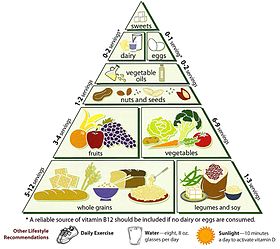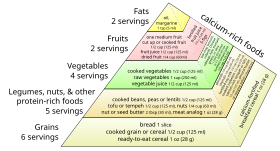
Vegetarianism is the practice of abstaining from the consumption of meat. It may also include abstaining from eating all by-products of animal slaughter.
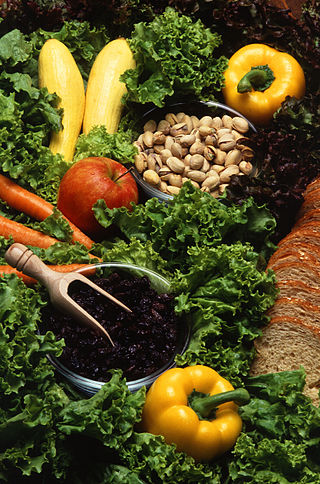
Vegetarian cuisine is based on food that meets vegetarian standards by not including meat and animal tissue products.

A food pyramid is a representation of the optimal number of servings to be eaten each day from each of the basic food groups. The first pyramid was published in Sweden in 1974. The 1992 pyramid introduced by the United States Department of Agriculture (USDA) was called the "Food Guide Pyramid" or "Eating Right Pyramid". It was updated in 2005 to "MyPyramid", and then it was replaced by "MyPlate" in 2011.

A lacto-vegetarian diet is a diet that abstains from the consumption of meat as well as eggs, while still consuming dairy products such as milk, cheese, yogurt, butter, ghee, cream, and kefir.

A flexitarian diet, also called a semi-vegetarian diet, is one that is centered on plant foods with limited or occasional inclusion of meat. For example, a flexitarian might eat meat only some days each week. Flexitarian is a portmanteau of the words flexible and vegetarian, signifying its followers' less strict diet pattern when compared to vegetarian pattern diets.

In nutrition, diet is the sum of food consumed by a person or other organism. The word diet often implies the use of specific intake of nutrition for health or weight-management reasons. Although humans are omnivores, each culture and each person holds some food preferences or some food taboos. This may be due to personal tastes or ethical reasons. Individual dietary choices may be more or less healthy.

A plant-based diet is a diet consisting mostly or entirely of plant-based foods. Plant-based diets encompass a wide range of dietary patterns that contain low amounts of animal products and high amounts of plant products such as vegetables, fruits, whole grains, legumes, nuts and seeds. They do not need to be vegan or vegetarian but are defined in terms of low frequency of animal food consumption.

Vegetarian nutrition is the set of health-related challenges and advantages of vegetarian diets.
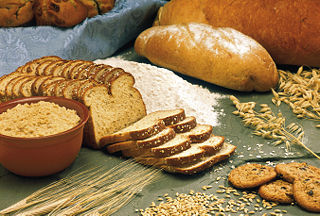
A food group is a collection of foods that share similar nutritional properties or biological classifications. List of nutrition guides typically divide foods into food groups and Recommended Dietary Allowance recommend daily servings of each group for a healthy diet. In the United States for instance, USDA has described food as being in from 4 to 11 different groups.
Protein combining or protein complementing is a dietary theory for protein nutrition that purports to optimize the biological value of protein intake. According to the theory, vegetarian and vegan diets may provide an insufficient amount of some essential amino acids, making protein combining with multiple foods necessary to obtain a complete protein food. The terms complete and incomplete are outdated in relation to plant protein. In fact, all plant foods contain all 20 essential amino acids including the 9 essential amino acids in varying amounts.

The Mediterranean Diet Pyramid is a nutrition guide that was developed by the Oldways Preservation Trust, the Harvard School of Public Health, and the World Health Organization in 1993. It summarizes the Mediterranean Diet pattern of eating, suggesting the types and frequency of foods that should be enjoyed every day.

Lacto-ovo vegetarianism or ovo-lacto vegetarianism is a type of vegetarianism which forbids animal flesh but allows the consumption of animal products such as dairy and eggs. Unlike pescetarianism, it does not include fish or other seafood. A typical ovo-lacto vegetarian diet may include fruits, vegetables, grains, legumes, meat substitutes, nuts, seeds, soy, cheese, milk, yogurt and eggs.
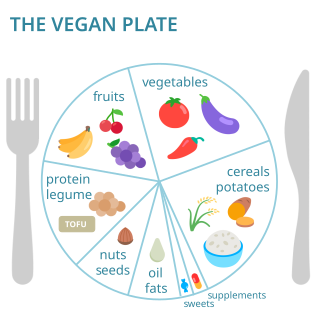
Vegan nutrition refers to the nutritional and human health aspects of vegan diets. A well-planned, balanced vegan diet is suitable to meet all recommendations for nutrients in every stage of human life. Vegan diets tend to be higher in dietary fiber, magnesium, folic acid, vitamin C, vitamin E, iron, and phytochemicals; and lower in calories, saturated fat, cholesterol, long-chain omega-3 fatty acids, vitamin D, calcium, zinc, and vitamin B12.

MyPlate is the current nutrition guide published by the United States Department of Agriculture's Center for Nutrition Policy and Promotion, and serves as a recommendation based on the Dietary Guidelines for Americans. It replaced the USDA's MyPyramid guide on June 2, 2011, ending 19 years of USDA food pyramid diagrams. MyPlate is displayed on food packaging and used in nutrition education in the United States. The graphic depicts a place setting with a plate and glass divided into five food groups that are recommended parts of a healthy diet. This dietary recommendation combines an organized amount of fruits, vegetables, grains, protein, and dairy. It is designed as a guideline for Americans to base their plate around in order to make educated food choices. ChooseMyPlate.gov shows individuals the variety of these 5 subgroups based on their activity levels and personal characteristics.
The history of USDA nutrition guidelines includes over 100 years of nutrition advice promulgated by the USDA. The guidelines have been updated over time, to adopt new scientific findings and new public health marketing techniques. The current guidelines are the Dietary Guidelines for Americans 2015–2020 and have been criticized as not accurately representing scientific information about optimal nutrition, and as being overly influenced by the agricultural industries the USDA promotes.
Pregnancy vegetarianism is the practice of adhering to a vegetarian diet during pregnancy. Vegetarianism is "the principle or practice of excluding all meat and fish, and sometimes, in the case of vegans, all animal products from one's diet." Although some people frown upon pregnant women practicing vegetarianism, there is no evidence that vegetarianism—practiced properly—is unhealthful during pregnancy. There are millions of healthy babies born each year from vegetarian households.

As in the human practice of veganism, vegan dog foods are those formulated with the exclusion of ingredients that contain or were processed with any part of an animal, or any animal byproduct. Vegan dog food may incorporate the use of fruits, vegetables, cereals, legumes including soya, nuts, vegetable oils, as well as any other non-animal based foods.
A vegan school meal or vegan school lunch or vegan school dinner or vegan hot lunch is a vegan option provided as a school meal. The meals have become part of the menu in some public school districts. Vegan school meals most reported on by the media include those added by Los Angeles, California in 2018, Portland, Maine in 2019, and New York City in 2022. A small number of private educational facilities around the world are vegan schools and serve exclusively vegan food.
